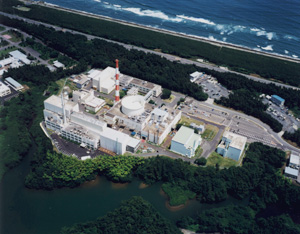My recent posts have been about breeder reactors which generate more fissile material than they consume. There is renewed global interest in breeder reactors for the production of nuclear fuel and the destruction of nuclear waste. Today's post is the first in a series about the history and current status of breeder reactors in Japan.
In 1956, the Japanese Atomic Energy Commission (JAEC) published the first Japanese Long Term Plan for nuclear energy. In the plan, fast breed reactors with their closed fuel cycle were chosen for serious research and development (R & D). Light water reactors from the United States were chosen for power generation.
Another Long Term Plan produced by JAEC in 1967 stated that fast breeder reactors should be the basis for future nuclear power generation. The Power Reactor and Nuclear Fuel Development Corporation (PNC) was created as the main R & D organization to pursue fast breeder reactor technology. The intention of the plan was to build an experimental fast breeder reactor in the 1970s and to have the first commercial fast breeder power reactor operational by the end of the 1980s.
The experimental Joyo fast breeder reactor was the first such reactor built in Japan. It went critical in 1977 at the Nuclear Cycle Development Institute's Oarai Engineering Center. A new core design was installed and went critical in 1982. In the same year, there was R & D on reprocessing spent fuel from Joyo. Joyo was a test system for irradiating fuels and construction materials from 1983 to 2000. Then a third core design was installed and the Joyo continues to operate.
In light of problems with funding, design and construction of fast breeder reactors, in 1987 the JAEC pushed back the commercialization of fast breeder reactors to the 2030s and affirmed that light water reactors would be the source of commercial power generation for the near future.
Monju is a fast breeder reactor prototype that was designed in parallel with Joyo but due to construction problems, it did not go critical until 1994. In late 1995, there was a severe sodium leak at in the Monju reactor that led to a fire when the sodium reacted with oxygen outside containment. The fire was so hot that steel structures melted. Unfortunately, PNC covered up the accident. When it was finally revealed, there was a serious backlash from the Japanese public.
A plan to build a six hundred and sixty megawatt demonstration fast breeder reactor for commercial power generation was unveiled by Japan Atomic Power Company in 1994. After the problems and public concern with Monju, the demonstration reactor project was cancelled in the late 1990s.
The Recycle Equipment Test Facility was constructed by PNC starting in 1995. It was the prototype reprocessing facility to extract fissile materials from spent fuel from Joyo. PNC worked with the Oak Ridge National Laboratory in the U.S. under a nuclear cooperation program between Japan and the U.S. The first phase of construction ended in the year 2000 but the expected completion date has not yet been announced.
PNC repaired Monju and applied for a new license which was granted in late 2002. Legal challenges to the granting of the new license resulted in a Japanese court reversing the original approval of the construction of the plant in 1983. After two years of appeals, the Japanese Supreme Court threw out the withdrawal of approval and ruled in favor of PNC restarting Monju. PNC intended to restart Monju in 2007 but it has still not been restarted.
While the commitment of the Japanese government to the development of fast breeder reactors has remained firm, the funding for such reactors and the public support has declined steadily from the 1960s to the 2000s. The commercialization of fast breeder reactors is now projected to be in 2050s.
Joyo experimental fast breeder reactor:
